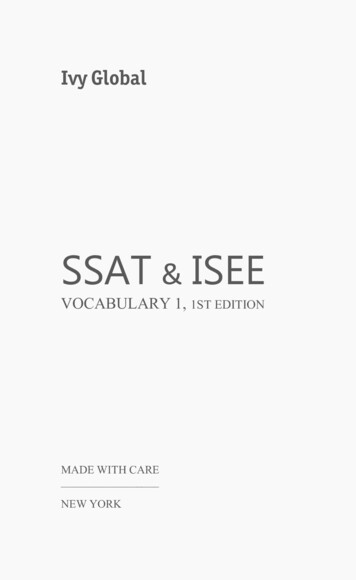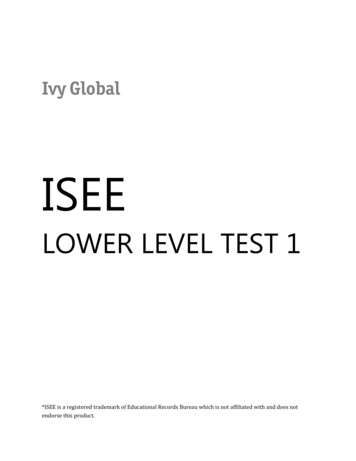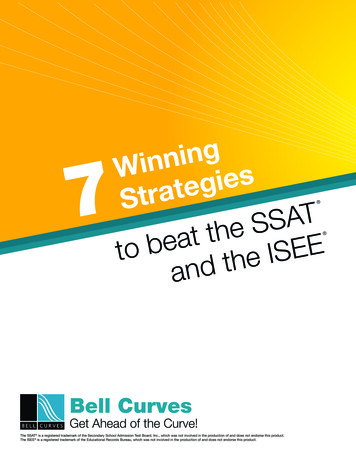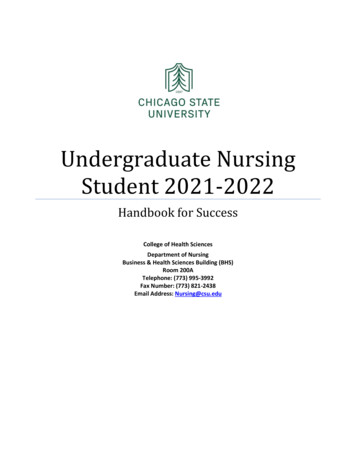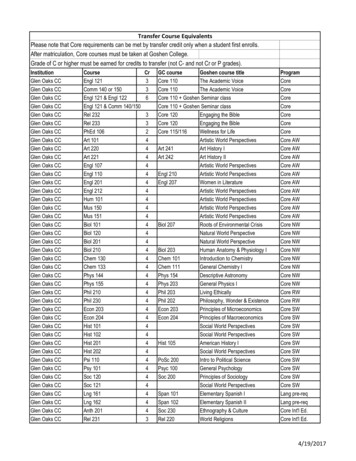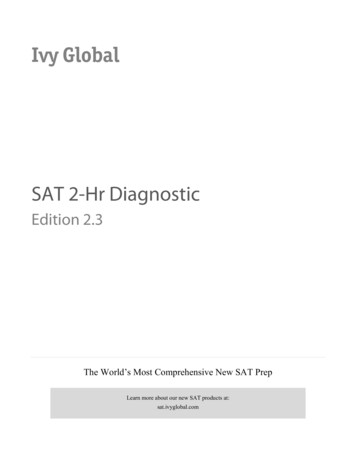
Transcription
Ivy GlobalISEE PRACTICELook inside this book: Table of Contents Lower Level – Quantitative Reasoning (p 45-53) Middle Level – Reading Comprehension (p 140-152) Upper Level – Mathematics Achievement (p 250-259)Version 1.0Distribution of our PDF files without consent is prohibited by law. Downloaded files may include a digital signature to trackillegal distribution. Suspected piracy may also be reported to the US ISBN agency.ISEE is a registered trademark of the Educational Records Bureau, which is not affiliated with and does not endorse thisproduct.
CONTENTSCHAPTER 1: INTRODUCTION . 1How to Use this Book . 3About the ISEE . 5CHAPTER 2: TEST-TAKING STRATEGIES . 11Approaching the ISEE . 13CHAPTER 3: PRACTICE TESTS . 29Practice Test 1: Lower Level . 33Practice Test 2: Lower Level . 73Practice Test 3: Middle Level . 115Practice Test 4: Middle Level . 163Practice Test 5: Upper Level . 211Practice Test 6: Upper Level . 261CHAPTER 4: ANSWER KEYS . 309Practice Test 1: Lower Level . 311Practice Test 2: Lower Level . 317Practice Test 3: Middle Level . 323Practice Test 4: Middle Level . 329Practice Test 5: Upper Level . 335Practice Test 6: Upper Level . 342
2QRSection 21Quantitative Reasoning38 QuestionsTime: 35 minutesEach question is followed by four suggested answers. Read each question and then decide which one of the foursuggested answers is best.Find the row of spaces on your answer document that has the same number as the question. In this row, markthe space having the same letter as the answer you have chosen. You may write in your test booklet.EXAMPLE 1:What is the value of the expression (4 6) 2?Sample Answer (A) 2(B) 4(C) 5(D) 7The correct answer is 5, so circle C is darkened.EXAMPLE 2:A square has an area of 25cm2. What is the length of one of itssides? (A) 1 cm(B) 5 cm(C) 10 cm(D) 25 cmSTOP. Do not go onuntil told to do so.Ivy GlobalSTOPPRACTICE TEST 1 45
2QR1.The large square shown below has beendivided into smaller squares.2.Which expression is equivalent to theexpression (2 3) 4?1(A) 5 4(B) 5 4(C)23 4(D) 5 14What fraction of the large square isshaded?(A) 5 5(B) 1 2(C) 1 3(D) 1 53.Four students were asked to walk, jog, and sprint around a track. Every two minutes, their speedswere recorded in the table below.Times2 min4 min6 min8 0 km/hr5.00 km/hr5.00 km/hr5.00 km/hr11.50 km/hr11.00 km/hr10.50 km/hr10.00 km/hr20.00 km/hr16.00 km/hr14.00 km/hr13.00 km/hrAccording to the pattern in this table, what would be the predicted speed of the sprinting student at10 minutes?(A) 14.00 km/hr(B) 12.50 km/hr(C) 10.00 km/hr(D) 8.50 km/hrGo on to the next page PRACTICE TEST 1 46Ivy Global
2QR4.Which story best suits the equation 21 7 3?7.(A) Susie has 21 pieces of gum that shewants to share equally between her 7friends. How many pieces of gumdoes she give each friend?(A) (𝑎 4) 2 2 𝑎12(C) 𝑎 2 4 2 𝑎(D)8.(D) Susie has 21 pieces of gum and gives3 packs of gum to her friend. Howmany packs of gum does Susie haveleft?5.11(B) 𝑎 4 𝑎 2(B) Susie had 21 pieces of gum and ate 7.How many pieces of gum did she haveleft?(C) Susie has 21 packs of gum, each with7 pieces. How many pieces of gumdoes Susie have?Which equation can be read as “4 lessthan half a number is equal to 2 morethan the number?” Let a represent theunknown number.𝑎2 4 𝑎 2Use the pattern to help answer thequestion.X X O, X X X O, X X X X O, Which comes next?(A) X X X X X X X OUse the number line to answer thequestion.(B) X X X X X O(C) X X X X X(D) X X X X X O9.What values are the arrows pointing to?Andrea and Zach walk home togetherafter school at a constant speed of 13kilometers per hour. Zach’s house is threetimes farther from school than Andrea’shouse. If it takes Zach 33 minutes to walkhome, how long does it take Andrea towalk home?(A) 2.3, 2.4(A) 11 minutes(B) 2.8, 3.2(B) 13 minutes(C) 3.2, 3.6(C) minutes(D) 4.0, 4.1(D) 66 minutes2.06.Which is the smallest fraction?(A) 2 3(B) 14 30(C) 4 7(D) 5 104.410. Jeff is thinking of a prime numberbetween 1 and 20. Jeff says that thenumber is greater than 11 and less than17. What number is Jeff thinking of?(A) 11(B) 12(C) 13(D) 15Go on to the next page Ivy GlobalPRACTICE TEST 1 47
2QR11. A survey of 32 artists’ favorite colors is displayed in the circle graph below.1Artists' Favorite ColorsBlueRedGreenPurpleApproximately what fraction of the artists chose blue as their favorite color?(A) 1 8(B) 1 4(C) 2 7(D) 3 812. The triangle below has an area of Ainches. If the formula for the area of atriangle is area 1213. Use the equations to answer the question.4𝑎 8base height, whichequation would tell you the length of thetriangle’s base in inches?2 𝑏 3What is the sum of 𝑎 and 𝑏?(A) 1(B) 2(C) 34 in(D) 6base(A) base 𝐴 2(B) base 𝐴 2(C) base 𝐴 2 4(D) base 𝐴 4 4Go on to the next page PRACTICE TEST 1 48Ivy Global
2QR14. Use the diagram to answer the question.16. Lucy has a bag full of marbles of variouscolors. The probability of choosing a redmarble is 5 out of 12. Which combinationof marbles is possible?1(A) 5 red marbles and 12 others(B) 15 red marbles and 36 others(C) 24 red marbles and 10 othersWhich piece would complete the diagramto make a square?(D) 20 red marbles and 28 others17. For which pair of symbols below do bothsymbols have the same number of lines ofsymmetry?(A)(A) (B) (C) (B)(D) 18. Use the Venn diagram to answer thequestion.(C)Candiesthat arelollipops orjelly beansCandiesthat aresour(D)15. Use the following equation to answer thequestion.𝑝 15 𝑞What candy could be found in the centerof the Venn diagram?(A) A sugary lollipopBy which number can 𝑞 be dividedwithout leaving a remainder?(B) A sour jelly bean(A) 2(D) A sour piece of gum(C) A sugary jelly bean(B) 3(C) 4(D) 10Go on to the next page Ivy GlobalPRACTICE TEST 1 49
2QR19. The figure below shows Julie’s juice boxafter she drank some of the juice.21. Rachel has four bags of candy. Two of the11bags weigh 3 lb, one bag weighs 4 lb, and2one bag weighs 5 lb. What is the meanweight of all four bags?(A) 4 lb1(B) 4 lb43(C) 4 lb81(D) 4 lb2If Julie has 150 mL of juice left, then howmuch juice did Julie drink?22. The perimeter of a square is 16w. What isthe length of one side?(A) 4(A) 250 mL(B) 8(B) 200 mL(C) 4𝑤(C) 150 mL(D) 8𝑤(D) 100 mL20. Use the table to determine the rule.23. The length of 𝐴𝐵 is 𝑥, the length of 𝐵𝐶 is𝑦, and the length of 𝐵𝐷 is 𝑧.InputOutput 10What is the length of AD?23(A) 𝑥 𝑦 𝑧49(B) 𝑥 – 𝑦 𝑧1027(C) 𝑦𝑧2675What is the rule for the function?(A) 3 3 AD(D) 𝑥 𝑧24. Use the two equations below to answerthe question:3 2 18(B) 3 3 3(C) 2 7 (D) 4 1 CBWhat is the value of ?(A) 2(B) 3(C) 4(D) 5Go on to the next page PRACTICE TEST 1 50Ivy Global
2QR25. Use the figure below to answer thequestion.28. 8 small boxes, shown as a shaded box inthe figure below, can fit into a largerrectangular box.1If the length and the width of the figurewere both increased by two units, whatwould be the new perimeter of the figure?(A) 22 units(B) 26 units(C) 28 units(D) 42 unitsThe volume of the large rectangular box is16 units3. What is the volume of eachsmall box?(A) 1 units326. What is the value of 𝑏 in the expressionbelow?16 48 24 𝑏8(A) 2(B) 4(C) 6(D) 827. Leslie bought 416 erasers for 0.27 each.Which expression gives the best estimateof the total amount of money she spent?(B) 2 units3(C) 4 units3(D) 64 units329. Sam has a bag with 18 pieces of chocolate,gummies, and mints. There are threetimes as many chocolates as there aregummies, and twice as many gummies asthere are mints. How many mints doesSam have?(A) 6(B) 4(A) 42 3(C) 2(B) 41 27(D) 1(C) 400 0.3(D) 300 2.7Go on to the next page Ivy GlobalPRACTICE TEST 1 51
2QR30. Rushen had three bottles of soda. Eachbottle contained two liters of soda, andshe divided the soda equally into 20glasses for her friends. How much sodadid she pour into each glass?(A)(B)(C)1103101233. Alex did the problem shown with hiscalculator.127 18959What is a reasonable estimation for hisanswer?LL(A) between 50 and 150(B) between 150 and 250L(C) between 500 and 1,500(D) 6 L(D) between 1,500 and 2,50031. Kim’s house is 11 km from Joe’s house. Onthe map, this distance is represented by5.75 cm. How many kilometers does 66cm represent?34. How many small unit squares would youneed to build a larger square where eachside has a length of 3 unit squares?(A) 30 km(B) 34.5 km(C) 40.75 km(D) 52 kmlarger squareunit square32. Use the figure shown to answer thequestion.(A) 3(B) 8A(C) 9(D) 12BF35. Use the number line shown to answer thequestion.ACDELucy wants to use the figure above todraw different quadrilaterals. She canonly trace the straight lines connectingthe points A, B, C, D, E, and F. How manyquadrilaterals can she draw?A2B11(A) 0The value of B is the difference betweenanother number and A. What is the othernumber?(B) 3(A) 28(C) 4(B) 20(D) 6(C) 8(D) 2Go on to the next page PRACTICE TEST 1 52Ivy Global
2QR36. Five students timed how long it takes them to walk to school and recorded the data in the graphshown below.1Time Spent Walking to School40Time ich of the following statements is correct?(A) The mean (average) walking time is between 25 and 35 minutes(B) It takes Andrea twice as long to walk to school as it does Kevin.(C) The range of the data is greater than the number of minutes it takes Andrea to walk toschool.(D) It takes Daniel longer to walk to school than all of the other students combined.37. The perimeter of the shape below is 16.5inches.?5 in.3 in.38. Eloise flips a two-sided coin 100 times.The coin has an equal probability oflanding on the “heads” side or landing onthe “tails” side, and Eloise records whichside it lands on after each flip. Which ofthe following most likely resemblesEloise’s results?(A) 94 heads, 6 tails(B) 100 heads, 100 tails4 in.(C) 47 heads, 53 tails(D) 0 heads, 100 tailsWhat is the length of the missing side?(A) 6 in.(B) 4.5 in.(C) 3.5 in.(D) 2 in.STOP. Do not go onuntil told to do so.Ivy GlobalSTOPPRACTICE TEST 1 53
3RCSection 31Reading Comprehension36 QuestionsTime: 35 minutesThis section contains six short reading passages. Each passage is followed by six questions based on its content.Answer the questions following each passage on the basis of what is stated or implied in that passage. You maywrite in your test booklet.STOP. Do not go onuntil told to do so.PRACTICE TEST 3 140STOPIvy Global
3RCQuestions 1–61234567891011121314151617181920212223A green leaf is green because of thepresence of a pigment known as chlorophyll,but chlorophyll is not the only pigment in aleaf. Leaves also contain yellow and orangepigments that are present in the leafthroughout its life, and red and purplepigments that develop under certain conditionsin the late summer. However, as long as the leafhas plenty of chlorophyll, green will be thedominant color.Chlorophyll has a vital function: itcaptures solar rays and utilizes the resultingenergy to manufacture the plant's food througha process called photosynthesis, which can alsobe observed in algae. The simple sugars thatare produced during this process from waterand carbon dioxide gas are the sole source ofthe carbohydrates the plant needs for growthand development.Throughout the spring and summer, theplant continually replenishes the chlorophyll inits leaves so that they can keep producing itsfood. In late summer, as daylight hours 45and temperatures cool, the veins that carryfluids into and out of the leaf are graduallyclosed off as a layer of special cork cells formsat the base of each leaf. As this cork layerdevelops, the flow of chlorophyll into the leafdecreases, slowly at first, and then rapidly.Eventually, the flow of the replacementchlorophyll cannot keep pace with the rate atwhich the chlorophyll is used up, and the leafbegins to change colors. Without thechlorophyll there to mask them, the yellow,orange, red, and purple colors of the other leafpigments begin to show through.The colors revealed by the absence ofchlorophyll can be vibrant and beautiful,though they only last for a few weeks in the fall.Certain areas, like southern Canada and theeastern United States, are even internationallyfamous for the brilliance of their “fall foliage.”These areas and others often attract touristscalled “leaf peepers” who travel great distancesfor a chance to see the changing leaves.Go on to the next page Ivy GlobalPRACTICE TEST 3 141
3RC1.According to the passage, a leaf’s supplyof chlorophyll is replenished by4.(A) the formation of cork cells at the baseof each leaf.Which question could be answered byinformation given in the passage?1(A) What causes the seasons to change?(B) Why are leaves green, and why dothey change color?(B) water condensation from theatmosphere.(C) Why are some trees always green?(C) veins that transport fluids into eachleaf.(D) Why do plant leaves contain yellowand orange pigments?(D) the production of carbohydrates.5.2.As it is used in line 11, “vital” most nearlymeans(A) explain why leaves are green.(A) critical.(B) provide evidence that contradicts thefirst paragraph.(B) energetic.(C) active.(C) describe the role of chlorophyll inplants.(D) refreshing.3.(D) summarize the main idea of thepassage.Red, yellow, and purple leaf pigmentsreveal themselves(A) during the process of photosynthesis.(B) when a leaf has less chlorophyll.The function of the second paragraph(lines 11–19) is to6.It can be inferred from the passage thatthe more chlorophyll a leaf has(C) on cloudy days.(A) the greener it will be.(D) when a leaf has more chlorophyll.(B) the less green it will be.(C) the less food it can produce.(D) the colder it will be.Go on to the next page PRACTICE TEST 3 142Ivy Global
3RCQuestions 72829Nicknamed the “City of Angels,” LosAngeles is a global city, known for its strengthsin business, entertainment, media, technology,and sports. The city is home to renownedcultural institutions like the Hollywood Bowland Getty Center, and is one of the mostsubstantial economies within the United States.But this paradise is not without itsproblems: owing to its geography, and heavytraffic, Los Angeles suffers from debilitating airpollution in the form of smog. The Los AngelesBasin is susceptible to atmospheric inversion,meaning the air closest to the earth’s surface iscolder than the air above. This phenomenontraps the cooler air and the exhaust from roadvehicles, airplanes, and other sources close tothe ground. Further, unlike other large citiesthat rely on rain to clear smog, Los Angeles getsonly 15 inches of rain each year, allowingpollution to accumulate over many consecutivedays. These factors make smog a pressing issuefor the city, and the 2006 and 2007 annualreports of the American Lung Associationranked the city as the most polluted in thecountry.To tackle this issue, Los Angeles decidedto take a legal approach. In 2008 a law waspassed allowing the city to collect fees fromthose using its port for shipping, with the 525354555657raised directed to local air quality projects. Thestate of California also updated its emissionstandards in 2012, making them the strictest inthe country. As a result, the number of severesmog alerts in Los Angeles has declined fromover 100 per year in the 1970s to almost zeroin recent years. Smog is expected to continue todrop in the coming years due to newtechnologies like electric and hybrid cars.Despite these improvements, much workremains to be done. Indeed, in 2013 LosAngeles was still ranked as having the nation'sworst smog. One opportunity that the cityshould consider is working to improve itspublic transit system. While Los Angelesalready has an extensive bus network, which isthe second busiest in the country, only about10% of the city’s residents make use of it. Bycontrast, other large American citiessometimes see a quarter or more of theirinhabitants opting for buses, subways, andtrains; in recent years over 50% of New YorkCity residents used such methods to travel towork. Encouraging more citizens to utilizepublic transportation rather than taking theirown cars could be the final piece of thepollution puzzle that gives Los Angeles thecleaner air it craves.Go on to the next page Ivy GlobalPRACTICE TEST 3 143
3RC7.The main purpose of this passage is to(A) describe the history of innovation inlos angeles.8.1(B) explain the concept of atmosphericinversion.(A) The measures Los Angeles hasalready taken to limit smog have beenhelpful but insufficient.(C) discuss the problem of smog in losangeles and some possible solutions.(B) So far Los Angeles has done nothingto fight smog.(D) argue for better public transit in losangeles.(C) Even without further action, thecurrent levels of smog in Los Angelesare acceptable.Which best describes the way the passageis organized?(D) Improving public transit is the onlyway to further reduce smog in LosAngeles.(A) A series of contradictory solutionsare presented.(B) A problem and early solutions aredescribed, and a further proposal isdiscussed.(C) A popular view is presented and thenchallenged by scientific evidence.(D) A problem is introduced and thenanalyzed.9.10. The author is most likely to agree withwhich one of the following statements?In line 21 “pressing” most nearly means(A) serious.(B) forceful.(C) chronic.(D) constricted.11. According to the passage, besidesgeography, the largest cause of smog andpollution in Los Angeles is(A) industry.(B) entertainment.(C) climate.(D) transportation.12. It can be inferred from the passage thatelectric and hybrid cars(A) produce more pollution thantraditional cars.(B) cannot be used in the los angelesbasin.(C) will encourage more citizens toutilize public transportation.(D) produce less pollution thantraditional cars.Go on to the next page PRACTICE TEST 3 144Ivy Global
3RCQuestions 13–18123456789101112131415161718192021222324To buy a horse was my greatestambition. My father died; and as misfortunesseldom come singly, the horse on which myfamily depended to till our scanty fields diedshortly after its owner. Whenever the springarrived, our one chance to plant a crop was tohire a mule from our nearest neighbor, thetanner. I was the eldest son, and my motherhad only my work to offer in payment. Thetanner always greeted this proposition coldly.The mule was needed to haul up piles of barkfrom the depths of the woods to the tanyard.Then, too, he had his own crops to plant.Although the mule was a multifarious animalthat ploughed and worked in the bark-mill, andhauled bark from the woods, and took longjourneys with the wagon or under the saddle, itwas impossible for her to be in all the places inwhich she was urgently needed at the sametime. Therefore, to hire her out hardly seemedto benefit her master. Nevertheless, thisbargain was struck every spring. My povertystricken mother always congratulated herselfupon it, and it never occurred to her that amount of work that I did in the tanyard wasmore than enough payment for the few daysthat the tanner’s mule ploughed our little fields.I, however, was beginning to see that aboy to drive that mule around the bark-millwas as essential as the mule himself. AsProvidence had failed to furnish the tannerwith a son for this purpose - his familyconsisting of several small daughters—Isupplied a long-felt want.I appreciated that my mother wasoverreached, yet I could not see that she coulddo otherwise. I sighed for independence, for alarger opportunity. As I drove the mule roundthe limited circuit, my mind was far away. Ianxiously canvassed the future. I cherishedfiery, ambitious schemes–but always with asense of their futility. With my time thusmortgaged, I thought that my help to mymother was far less than it might be. But until Icould have a horse of my own, there was nohope—no progress. And for this I planned, anddreamed, and saved.Go on to the next page Ivy GlobalPRACTICE TEST 3 145
3RC13. When did the family’s horse die?(A) in the spring.(B) before the father died.(C) after the father died.(D) while it was plowing the field.14. What deal was struck every spring?(A) The tanner gave the narrator’s familysome bark, and the narrator’s motherlent him their horse.(B) The narrator drove the tanner’swagon, and the tanner helped thenarrator’s mother in the field.(C) The narrator gave the tanner hiscrops, and the tanner gave thenarrator a horse.(D) The tanner lent the narrator’s motherhis mule, and the narrator did workfor the tanner.15. What is the most likely reason that thenarrator’s family always struck this dealin the spring?(A) The spring was the time of the yearwhen they needed to till their fieldsto plant a crop.16. The passage answers all of the followingquestions EXCEPT which one?1(A) Did the narrator have an olderbrother?(B) What did the narrator’s family needthe mule for?(C) What did the narrator want morethan anything?(D) How many siblings did the narratorhave?17. In line 31 the word “furnish” most nearlymeans(A) provide.(B) appoint.(C) include.(D) trade.18. Which phrase means most nearly thesame as “this bargain was struck” (lines21-22)?(A) this deal was made.(B) we hit upon an idea.(C) the bargain was rejected.(D) we were astonished at the bargain.(B) Their old horse died in the spring.(C) The spring was the time of the yearwhen the tanner didn't need to usethe mule.(D) It was too cold to walk to the tanner'shouse during any other time of theyear.Go on to the next page PRACTICE TEST 3 146Ivy Global
3RCQuestions oudly raising four fingers—representing the four stripes of the Catalanflag—the enxaneta is greeted by uproariousapplause, which he or she can usually enjoyonly for a moment before scrambling down theother side of the human tower known as acastell.“Castell” is the Catalan word for, as anEnglish-speaker might guess, “castle.” Castellsare a Catalan tradition dating back to the 18thcentury, when they were first built during localfestivals in the city of Valls. Today, castellteams—or colles—build elaborate humantowers during festivals throughout Catalonia,as well as in competition.While castell teams were traditionallyall-male, today’s colles are as diverse as thecommunities they come from, uniting men andwomen of all ages in a feat that is bigger thanthemselves. Each level of the castell is formedby two to five people standing on the shouldersof those in the level below. The enxaneta is thebrave soul, almost always a child, who climbsto the top of a castell to mark its completion.Then begins the treacherous process 9dismantling the many levels (as many as ten) ofcastellers who make up the tower. This is themost treacherous stage of the activity, whenparticipants are most likely to fall. But thedanger is not quite as great as it might seem—hundreds of supporters form a pinya, or base,for the castell, cushioning the fall of thecastellers in case of collapse. In ademonstration of the sportsmanship foundamong castellers, when not competing evenmembers of rival colles will assist in forming apinya for another team that is attempting tobuild a particularly difficult structure.The traditional outfit for castellersusually consists of a pair of white trousers anda colorful shirt, often bearing the crest oremblem of the casteller’s team. The castellersgenerally do not wear protective equipment,with the exception of a sash, which providessupport for the lower back. Indeed, castellerstypically do not even wear shoes, which couldinjure the people on the lower levels of theCastell, and can actually make it harder tobalance.Go on to the next page Ivy GlobalPRACTICE TEST 3 147
3RC19. Which of the following statements wouldthe author most likely NOT agree with?22. According to the passage, what is the roleof the pinya (lines 29-33)?1(A) The completion of a castell is anexciting moment for the audience.(A) The pinya is a crowd of fans that willcheer the castellers even if they fail.(B) Today’s castell teams are better thanthose of the 18th century.(B) If the castellers lose their balance andfall, the supporters in the pinya willhelp them back onto their feet.(C) Building a castell is an impressiveachievement.(D) Castellers are actually safer than theiraudience might imagine.20. Which best expresses the main point ofthe passage?(A) Building castells started in the 18thcentury all over Catalonia as anactivity that brought men and womentogether.(B) Castells were first built by all-maleteams in 18th century Valls; today,men, women, and children build themtogether all over Catalonia.(C) Castells were once popularthroughout Catalonia but today aremainly built by the inhabitants ofValls.(D) Building castells is a new sport thatwas designed to heal social rifts byuniting diverse groups in pursuit of acommon goal.21. The attitude of the author towardscastells is best described as(A) alarmed.(C) If the castellers lose their balance andfall, they will fall safely onto the pinyainstead of hitting the ground.(D) The pinya is the child who goes to thetop of the castell to signal itscompletion.23. Which best describes the organization ofthe passage?(A) A specific event is introduced, andthen its history and process aredescribed.(B) A hypothesis is presented andarguments to support it are provided.(C) A specific event is introduced andthen criticized.(D) An opinion is presented, followed byfacts to support that opinion.24. In line 13 the word “elaborate” mostnearly means(A) complex.(B) frilly.(C) modest.(D) compact.(B) critical.(C) disbelieving.(D) admiring.Go on to the next page PRACTICE TEST 3 148Ivy Global
3RCQuestions 25-301The following is an excerpt from a speech by Lyndon B. Johnson, delivered in 1964.123456789101112131415161718A third place to build the Great Society isin the classrooms of America. There yourchildren's lives will be shaped. Our society willnot be great until every young mind is set freeto scan the farthest reaches of thought andimagination. We are still far from that goal.Today, 8 million adult Americans, more thanthe entire population of Michigan, have notfinished 5 years of school. Nearly 20 millionhave not finished 8 years of school. Nearly 54million -- more than one quarter of all America-- have not even finished high school.Each year more than 100,000 high schoolgraduates, with proved ability, do not entercollege because they cannot afford it. And if wecannot educate today's youth, what will we doin 1970 when elementary school enrollmentwill be 5 million greater than 1960?1920212223242526272829303132333435In many places, classrooms areovercrowded and curricula are outdated. Mostof our qualified teachers are underpaid, andmany of our paid teachers are unqualified. Sowe must give every child a place to sit and ateacher to learn from. Poverty must not be abar to learning, and learning must offer anescape from poverty.But more classrooms and more teachersare not enough. We must seek an educationalsystem which grows in excellence as it grows insize. This means better training for ourteachers. It means preparing youth to enjoytheir hours of leisure as well as their hours oflabor. It means exploring new techniques ofteaching, to find new ways to stimulate the loveof learning and the capacity for creation.Go on to the next page Ivy GlobalPRACTICE TEST 3 149
3RC25. The passage above mainly focuses on(A) arguing for improvements in theeducational system.28. When the speaker says that “we must giveevery child a place to sit” (line 23), he ismaking reference to1(B) outlining the problems witheducation.(A) the large number of adults who havenot graduated from high school.(C) encouraging more peop
Ivy Global ISEE PRACTICE Look inside this book: Table of Contents Lower Level - Quantitative Reasoning (p 45-53) Middle Level - Reading Comprehension (p 140-152) Upper Level - Mathematics Achievement (p 250-259) Version 1.0 Distribution of our PDF files without consent is prohibited by law. Downloaded files may include a digital signature to track
